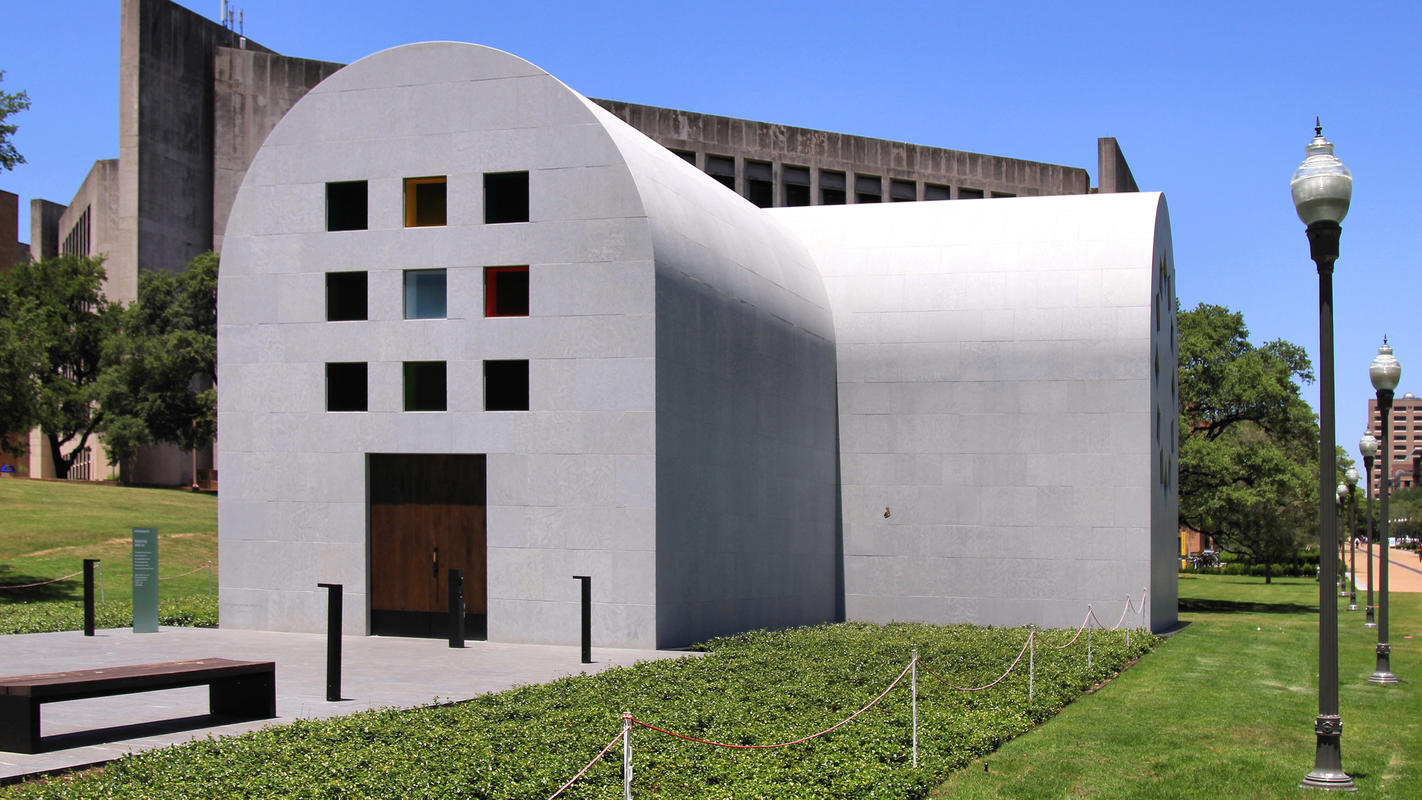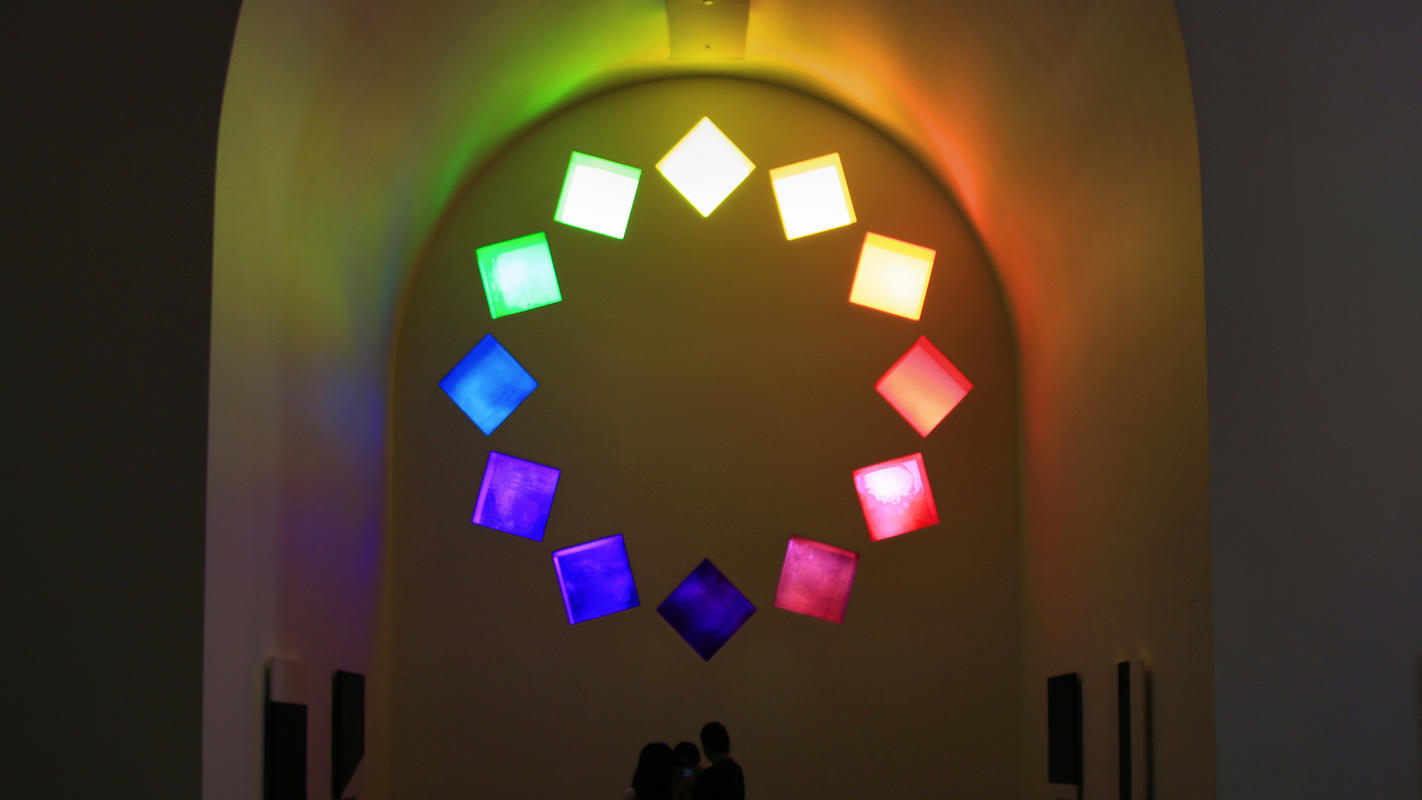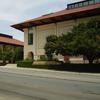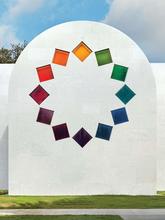More about Austin
- All
- Info
- Shop

Contributor
“Nonbeliever” and “transcendental anarchist” Ellsworth Kelly’s miniature cathedral, aptly named Austin after its location, stands as a monument to his artistic career but replaces religious imagery with light and color.
Light shines through the stained glass windows on each side of the cruciform structure, flooding the space with a technicolor glow that shifts according to the time of day, seasons, and weather conditions, creating an experience that is “deeply tied to nature and the universe.” Although Kelly did not intend the space to be a devotional one, as he insisted that the space would not be consecrated, immersive art installations such as this one tend to impose a visceral experience on the viewer. The rainbow stained glass creates a space that might feel devotional, but categorically, specifically, indubitably, is NOT. One window even looks like the spinning wheel of death that pops up when your internet won’t load. The completion of this architectural feat gives eternal life to Kelly’s extensive career, including every medium of his work from painting to sculpture and ultimately to architecture.
Initially designed for the property of a Hollywood producer (the guy who produced Dynasty and The Love Boat), Kelly’s plans fell through when the challenge and expense of actually realizing this piece presented itself. After Kelly established himself as a major player in the art world, multiple collectors began vying for him to build this chapel for them.
You might not expect Texas to be a hub for modern art, but with the addition of Austin, the amount of permanent large-scale installations in the state continues to increase. Minimalist Donald Judd built his Chinati Foundation in Marfa, essentially in the middle of nowhere. Now a contemporary art museum based on the artist’s personal foundation, Judd’s Minimalist Disneyland initiated the practice of art tourism, which started to make Texas a destination for art lovers. James Turrell’s Live Oak Friends Meeting House stands as a devotional space in Houston where Quakers can meet for silent worship. Mark Rothko has another site-specific installation, also located in Houston, that serves as another artistic chapel but with a very different tone. While Kelly envisioned his chapel as a site for joy and contemplation, the Rothko Chapel remains pervaded by the artist’s suicide.
Kelly developed an interest in cathedrals during his time in France during World War II. When he returned to France after the war, he spent his leisure time biking through the southern part of the country, sketching Gothic and Romanesque cathedrals. Austin takes the canonical shape of a Roman Catholic devotional space, with a cruciform ground plan, double barrel vaults, and a central groin vault. Yes, it’s really called a groin vault. Quite literally, it takes place where the two barrel vaults cross, so at the crotch of the cross. How holy (hole-y?).
No matter your religious beliefs, powerful art can have a profound emotional impact on anyone, sometimes evoking a spiritual awakening of sorts. Kelly’s a-religious yet ethereal chapel Austin brings about this kind of experience in anyone who has the good fortune to make the pilgrimage to the Blanton Museum of Art at the University of Texas at Austin. It stands as a monument to Ellsworth Kelly’s lifelong artistic achievements and honors his devotion not to God or to theology, but to the power of art.
Sources
- Agresta, Michael. "Unveiling Ellsworth Kelly's 'Austin'." Texas Monthly. February 22, 2018. https://www.texasmonthly.com/the-culture/ellsworth-kelly-austin-unveile….
- Corbett, Rachel. "Ellsworth Kelly, an Atheist, Has Built a Transcendent Church for Art in Texas." Artnet News. February 20, 2018. https://news.artnet.com/art-world/ellsworth-kelly-chapel-opens-texas-bl….
- "Live Oak Friends Meeting (Houston)." Friends General Conference. https://www.fgcquaker.org/cloud/live-oak-friends-meeting-houston.
- Machida, Nicholas. “Minimalism and Pop Art.” Art History 131B: Contemporary Art of the 1960s and 1970s. Class Lecture, UCLA, Los Angeles, CA, 2018.
- Miller, M.h. "Ellsworth Kelly's Temple for Light." The New York Times. February 08, 2018. https://www.nytimes.com/2018/02/08/t-magazine/ellsworth-kelly-austin-la….
- Wolf, Eric Michael. "Form into Spirit: Ellsworth Kelly's Austin." CAA Reviews. June 11, 2018. http://caareviews.org/reviews/3421#.XT4wmi2ZMWq.
Featured Content
Here is what Wikipedia says about Austin (building)
Austin is an immersive work of art and architecture designed by artist Ellsworth Kelly and built on the grounds of the Blanton Museum of Art in Austin, Texas, USA. The building is a permanent installation and part of the museum's permanent collection.
Kelly's Austin relates to the tradition of modernist artist-commissioned buildings that includes the Rothko Chapel, the Thanks-Giving Square Chapel of Thanksgiving, and Henri Matisse's Matisse Chapel.
Check out the full Wikipedia article about Austin (building)















I have never been there to see how the building looks like but I like it. This building is pretty simple and doesn't have a lot of declarations. From this picture that I can know on each side, there are different patterns on the walls.